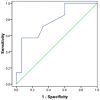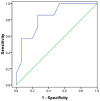Association of radiologic findings with mortality in patients with avian influenza H7N9 pneumonia
- PMID: 24705783
- PMCID: PMC3976364
- DOI: 10.1371/journal.pone.0093885
Association of radiologic findings with mortality in patients with avian influenza H7N9 pneumonia
Abstract
Background: The novel H7N9 virus causes severe illness, including pneumonia and acute respiratory distress syndrome, with high rates of mortality. We investigated the association of initial radiologic characteristics obtained at admission with clinical outcomes in patients with avian influenza H7N9 pneumonia.
Methods: Demographics, comorbidities, clinical findings, radiologic appearance and scores of the affected lung parenchyma were compared between survivor group (n = 15) and mortality group (n = 7). Two radiologic scores were calculated, one using chest radiography and one using CT. Follow-up CT scans at discharge were analyzed in 12 patients of the survival group.
Results: All the patients in mortality group developed acute respiratory distress syndrome and required mechanical ventilation, while in the survival group 33% (5/15) developed acute respiratory distress syndrome (P<0.05) and 27% (4/15) required mechanical ventilation (P<0.05). The mean radiographic and CT scores of the mortality group were 50% higher compared to the survival group (P<0.05). ROC analysis revealed an area under curve of 0.738 for the radiographic score with an optimal cutoff value of a score of 19 for prediction of mortality, with a sensitivity of 71% and a specificity of 67%, and an area under curve of 0.833 for the CT score with an optimal cutoff value of a CT score of 21 for prediction of mortality, with a sensitivity of 86% and a specificity of 73%. The mean CT score of the affected lung parenchyma at discharge was 30% lower than the initial CT examination (P<0.05).
Conclusion: High initial radiologic score is associated with mortality in patients with avian influenza H7N9 pneumonia.
Conflict of interest statement
Figures







References
-
- Tran TH, Nguyen TL, Nguyen TD, Luong TS, Pham PM, et al. (2004) Avian influenza A (H5N1) in 10 patients in Vietnam. N Engl J Med 350: 1179–1188. - PubMed
-
- Parry J (2013) H7N9 avian flu kills seven and infects 23 in China. BMJ 346: f2222. - PubMed
-
- Number of confirmed human cases of avian influenza A (H7N9) reported to WHO. Geneva: World Health Organization, May 2013. Available: http://www.who.int/influenza/human_animal_interface/influenza_ih7n9/05_R.... Accessed 2013 June 3.
-
- Gao HN, Lu HZ, Cao B, Du B, Shang H, et al. (2013) Clinical findings in 111 cases of influenza A (H7N9) virus infection. N Engl J Med 368: 2277–2285. - PubMed
-
- Lu SH, Xi XH, Zheng YF, Cao Y, Liu XN, et al. (2013) Analysis of the clinical characteristics and treatment of two patients with avian influenza virus (H7N9). Biosci Trends 7: 109–112. - PubMed
MeSH terms
Substances
LinkOut - more resources
Full Text Sources
Other Literature Sources
Medical

